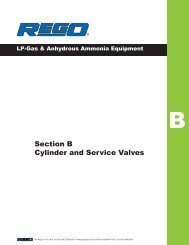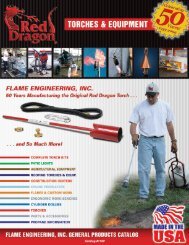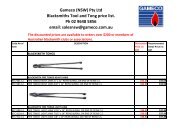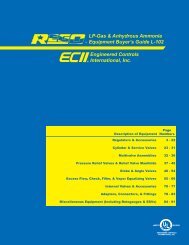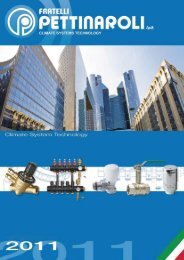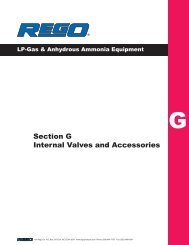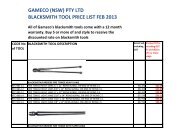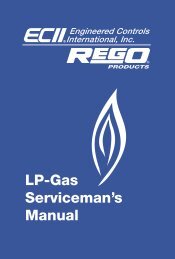Repair Kits Available By Part Number Section 2 Page - GAMECO
Repair Kits Available By Part Number Section 2 Page - GAMECO
Repair Kits Available By Part Number Section 2 Page - GAMECO
You also want an ePaper? Increase the reach of your titles
YUMPU automatically turns print PDFs into web optimized ePapers that Google loves.
Cable Control System<br />
The cable control system should be installed in accordance with the<br />
provisions of NFPA 58, ANSI, DOT, and all applicable federal, state,<br />
provincial and local codes.<br />
It is suggested that an external return spring be used when utilizing a<br />
cable system in order to overcome any drag in the control linkage.<br />
Inspect the cable system for binding that could cause the valve to stick<br />
in the open position.<br />
Thermal Latches<br />
Thermal Latches are designed to automatically hold the Internal Valve’s<br />
operating lever open when the lever is moved to an open position. If<br />
exposed to fire or extreme heat, the built-in fusible element is designed<br />
to melt and return the operating lever to the closed position.<br />
Pneumatic Actuators<br />
Pneumatic Actuator Systems provide a convenient means for opening<br />
and closing the internal valve from a remote location. Actuators utilize<br />
either air or nitrogen and are compatible with existing air interlock<br />
systems. They can be used to operate several Internal Valves on<br />
stationary storage tanks and can work in conjunction with Emergency<br />
Shut-off Valves.<br />
Valve Operation and Precautions<br />
1. Valve must be opened before starting pump, and before opening<br />
valve on pump outlet.<br />
2. Leave pumping system “wet” to avoid drying of seals and to reduce<br />
time involved in opening valve. Drain piping only when required by<br />
codes or safe operating practices.<br />
3. When piping is dry or at a lower pressure than the tank, open valve<br />
half-way for a few seconds to allow line pressure to equalize before<br />
fully opening the valve handle. The poppet may not open immediately<br />
if the handle is placed in the open position too quickly.<br />
4. Flow surges may close the built-in excess flow valve and should be<br />
avoided. If the excess flow valve slams shut; stop the pump, close<br />
the nearest downstream valve, and move handle to the mid-point<br />
position to equalize pressure until valve reopens with a click, then<br />
restart pump and open downstream valve slowly.<br />
5. Always keep valve closed except during product transfer.<br />
6. Completely open all valves during pumping. <strong>Part</strong>ially closed valves<br />
may prevent excess flow valve from closing when required, even in<br />
a properly designed piping system.<br />
7. All personnel must be aware of remote closure locations and their<br />
operation in case of an emergency. They must also be aware of the<br />
equalizing opening through which bleeding can occur after the<br />
excess flow valve closes. If this bleed is not stopped by closing a<br />
downstream valve, a hazard may occur.<br />
Troubleshooting<br />
1. Internal Valve Will Not Open<br />
Causes may be excess leakage downstream, pump engaged too<br />
quickly, excessive wear of the valve, or ice accumulation.<br />
When there is excessive volume downstream, a greater amount of<br />
time is required to equalize tank and downstream pressure.<br />
To determine if the pilot seat is opening, install a pressure gauge<br />
downstream of valve outlet while keeping the system closed downstream<br />
of the pressure gauge. Open any hand valves between the<br />
valve and pressure gauge, and open internal valve. Pilot seat is not<br />
opening if pressure does not build up to tank pressure. Perform this<br />
test with the pump off. A broken internal part may cause the pilot<br />
seat not to open.<br />
2. Premature Valve Closure<br />
First, check to see that the operating lever is properly connected and<br />
fully opens the valve. Premature closure may also be a result of;<br />
engaging pump too quickly, sudden line surges, an underrated<br />
excess flow spring or an obstructed inlet port.<br />
3. Valve Will Not Close<br />
Usually, the result of a faulty or sticking actuator. Check the actuator<br />
to see that it works freely by cycling it several times with the lever.<br />
If it sticks in the open position, repairs are required. Internal damage<br />
will also cause the valve not to close.<br />
4. Low Flow Capacity<br />
Downstream piping may be too small and/or long. The internal valve<br />
may be too small. The valve inlet may be restricted. There may be<br />
downstream restrictions or a bypass valve stuck in the open<br />
position. These are all possible causes of low flow.<br />
Maintenance<br />
Potential problems may be eliminated with preventative valve maintenance.<br />
Perform the following steps once a month.<br />
1. Check to see that the operating lever moves freely and smoothly.<br />
Check for leakage around the stem and sealing gland with a high<br />
quality leak detection solution. Leakage will require replacement of<br />
the sealing gland packing. A sticking lever indicates trapped foreign<br />
material or mechanism wear.<br />
2. Check seat disc for tight closure. Close internal valve and exhaust<br />
downstream pressure. Be sure piping is warmed to an ambient<br />
temperature. Install a pressure gauge between internal valve and<br />
first downstream valve. Close the first downstream valve and<br />
observe for pressure build-up between the two closed valves with<br />
pressure gauge. If leakage occurs, replacement of seat disc will be<br />
required.<br />
3. Inspect, clean and lubricate all exterior operating controls. Check<br />
controls to see that they open valve fully and that they freely close<br />
the valve. Worn parts should be replaced.<br />
4. Remove valve if the tank is to be steam cleaned. Heat may damage<br />
the valve seals and seats.<br />
5. Valve is not designed for water service. After tank is hydrostatically<br />
tested, immediately remove all water and allow tank to thoroughly<br />
dry out before installing valve.



